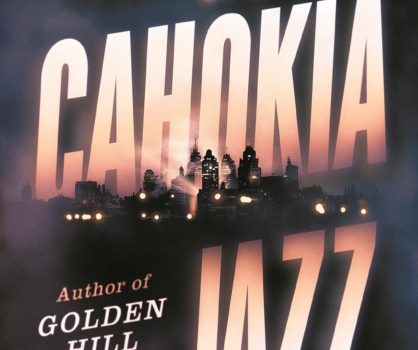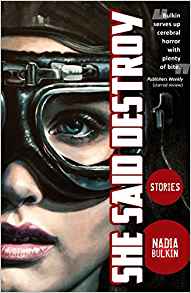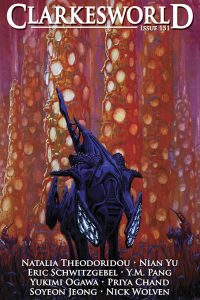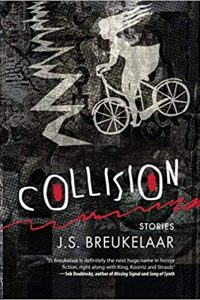Niall Harrison Reviews Cahokia Jazz by Francis Spufford
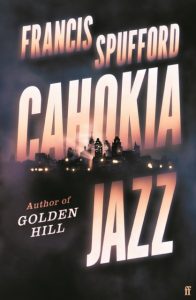 Cahokia Jazz, Francis Spufford (Faber & Faber 978-0-57133-687-6, £20.00, 496pp, hc) October 2023. (Scribner 978-1-66802-545-1, $28.00, 464pp, hc) February 2024.
Cahokia Jazz, Francis Spufford (Faber & Faber 978-0-57133-687-6, £20.00, 496pp, hc) October 2023. (Scribner 978-1-66802-545-1, $28.00, 464pp, hc) February 2024.
Francis Spufford’s enthusiasm for science fiction, and the variants of it that engage with historical process, is hardly a secret, but it’s taken a while for him to move from observer to participant. As long ago as 1996 he published a thoughtful essay on William Gibson & Bruce Sterling’s The Difference Engine and the mechanisms by which the best alternate histories provoke readerly awareness of contingency and possibility; his 2010 fiction/non-fiction hybrid Red Plenty both tiptoed right up to the line of alternate Soviet history, and included an entirely gratuitous footnote referencing Kim Stanley Robinson; and his previous novel, Light Perpetual (2021) tiptoed just over the line, imagining lives for five children killed during the London Blitz, without imaging any substantial knock-on societal changes. But now he’s done a long jump and stuck the landing with some style.
Cahokia Jazz is a rich and fluently imagined alternate history. Its point of divergence from our timeline is that a less virulent strain of smallpox is carried across the Atlantic in the 15th century, leaving much more robust Native societies throughout the Americas than in our timeline but particularly – from the novel’s point of view – in what becomes the American Midwest, where the local culture is able to respond and adapt to the arrival of Europeans from a position of greater strength. By the 1920s, the titular city and its surroundings are thriving as the crossroads of a somewhat different United States. As in Michael Chabon’s The Yiddish Policeman’s Union (2007), the vehicle for exploring the full nature of the city and its history is a noirish detective story that delves into the relationships between Cahokia’s different communities, namely the takouma (Native), the taklousa (Black), and the takata (white, or more precisely, as Spufford writes, ‘‘of European extraction’’). A grisly murder threatens to upset the status quo: in the early hours of a chilly Monday in March, the body of a takata is found on the roof of a government building, carved open in what is initially diagnosed as a politically motivated blood sacrifice.
Charged with investigating the murder are Phineas Drummond, another takata – scrawny, cynical, crass – and the novel’s protagonist, Joe Barrow, an orphan from Nebraska, ‘‘some kind of takouma-taklousa mix-up’’ – big, tentative, lost, lover of jazz. The pair of them are veterans from war in France; Barrow has since then tagged along wherever Drummond has led, without ever fully deciding what he himself believes in. The case takes them on a convenient tour of the vivid and varied regions of the city, from factories to Frank Lloyd Wright-designed villas, and introduces them to a cross-section of its inhabitants, from agitating communists to arrogant industrialists to enigmatic aristocrats. Spufford’s skill at keeping you reading, sentence after sentence, is for me up there with writers like David Mitchell and Mary Doria Russell – and as a writer of set-pieces he is exceptional, even if there’s nothing quite as showstopping here as the deconstructed bomb that opens Light Perpetual.
Ultimately Cahokia Jazz is most notable for the thought that’s gone into its thought-experiment. It demands the reader’s trust and faith as it unpacks its characters, plot, and ideas, and it invites debate about its choices. Barrow, for instance, attracts the attention of the powerful Hashi family: the old money of Cahokia, descended from takouma royalty, now nominally without titles except that somehow their number still includes Cahokia’s senator, its archbishop, a Hollywood film star, and the smoothly sophisticated ‘‘Man of the Sun,’’ the family’s prince. ‘‘I spend my days on symbolism,’’ the Man tells Barrow, making the point that his real and meaningful authority in the city derives only from symbolism, and from ‘‘the stories people tell.’’ He urges Barrow, in that light, to look at what stories the murder is being used to tell. Barrow’s initially ambivalent reaction is to wonder what story the Man might want to use him to tell, and meanwhile the reader might start to find Barrow himself, positioned as not quite insider, not quite outsider, a little too easily symbolic. There’s no doubt that the larger-than-life secret-master characterisation of the Man feels a little indulgent, in a way that risks removing Barrow’s agency, but Spufford balances it with a careful exploration of Barrow’s increasing political awareness and sense of belonging; in the end I thought he walked a delicate line with a fair degree of nuance.
Or consider the murder itself, and the way it is used as a jumping-off point for commentary about the city’s history. It’s not until we’re about a third of the way in – and after unchallenged tabloid screams about AZTEC SLAYING that might cause readers to twitch a little – that Barrow finds himself at a meeting of takouma intelligentsia, listening to an anthropologist’s lecture on the relationship between Aztec and Cahokian cultures, or rather the lack thereof. No sooner is this cleared up, however, then Spufford, via the anthropologist, introduces another framing to be considered. There is some evidence for cultural exchange between Aztec and Cahokian cultures, it seems, but mediated by a third party, the Society of Jesus.
On their arrival in the Americas, the Jesuits encouraged a practical syncretism of Catholic and Native thought. Spufford’s stated model is what he describes (in his afterword) as the ‘‘genuinely impressive’’ Jesuit missions with the Guaraní in what is now Paraguay, which is to say he imagines missions that mitigate some of the worst violence of wider European colonialism. Exactly how much mitigation was achieved by the missions with the Guaraní is debated, but a reader of Cahokia Jazz must be able to believe in the possibility of this less-negative first contact outcome, because they must care about the potential unravelling of its achievements. The anthropologist mentioned above sums up what he sees as the city’s value: ‘‘There is little in Cahokia that has not been molded and blended by the long contact,’’ he acknowledges, ‘‘Yet against all this must be placed the inestimable advantage that Cahokia thrives; that Cahokia is not a dying but a living culture.’’ The depiction in the book supports his claim, even as his identity reminds us of the wider power relations at play. Alfred Kroeber is one of the few real historical figures to appear in the novel, and in our world did influential work about and with Western tribes of Native Americans, but as with the Guaraní missions, his legacy is not unchallenged; the University of California, Berkeley has recently removed his name from its anthropology building amid debates about his research practices.
Adding yet another layer, Kroeber is also notable as the father of Ursula K. Le Guin, to whom Cahokia Jazz is dedicated, and as the novel moves into its closing stages, the noir (and Christian) search for belief in a fallen world is married with a distinctly Le Guinian line of questioning: how should a good society be maintained? Because however it came into being, there is much that is attractive about Cahokia, from its systems (there is no private ownership of land or other resources), to its institutions (being a cop ‘‘don’t mean quite the same thing here it does other places’’) to the day-to-day freedom of its citizens’ lives. Moreover, its existence appears to be having some positive, if incomplete, effects on broader American history; it is the sort of symbol that, in the Man’s phrasing, ‘‘gives a nudge to the world.’’ Perhaps Cahokia Jazz’s greatest achievement is the way in which it balances this symbolic potency with the hard reality of a living culture. Cahokia is no utopia. It is a human society and it makes compromises, and what Barrow and Drummond’s investigation demonstrates is that an inarguable good at the level of a world might still create an intolerable crisis at the level of an individual. But whether you walk away in the face of that crisis or, as N.K. Jemisin’s fiction has more recently argued, stay and fight, Cahokia Jazz is clear that the one thing you mustn’t do with the problem of Omelas is ignore it.
In Niall Harrison’s spare time, he writes reviews and essays about sf. He is a former editor of Vector (2006-2010) and Strange Horizons (2010-2017), as well as a former Arthur C. Clarke Award judge and various other things.
This review and more like it in the November 2023 issue of Locus.
 While you are here, please take a moment to support Locus with a one-time or recurring donation. We rely on reader donations to keep the magazine and site going, and would like to keep the site paywall free, but WE NEED YOUR FINANCIAL SUPPORT to continue quality coverage of the science fiction and fantasy field.
While you are here, please take a moment to support Locus with a one-time or recurring donation. We rely on reader donations to keep the magazine and site going, and would like to keep the site paywall free, but WE NEED YOUR FINANCIAL SUPPORT to continue quality coverage of the science fiction and fantasy field.
©Locus Magazine. Copyrighted material may not be republished without permission of LSFF.


